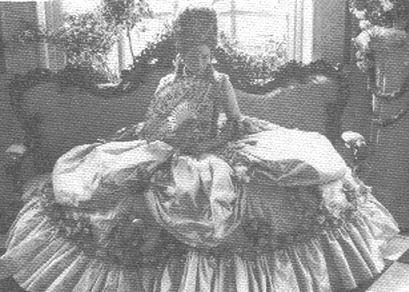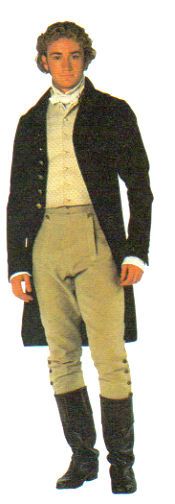Ellen and Jim Have a Blog, Too
We are two part-time academics. Ellen teaches in the English department and Jim in the IT program at George Mason University.


The importance of costume in costume dramas · 8 January 07
Dear Harriet,
A little more on film adaptations: particularly those which set historical novels in a costumed past. I’ve just finished an excellent study of costumes in drama: Pam Cook’s Fashioning the Nation: Costume and Identity in British Cinema. Cook argues for the centrality of costume and she defends the pleasure people who enjoy costume drama get from watching actors dressed up in semi-historical fashions on the grounds these encourage a playing with one’s identity in playful, transgressive and comforting ways. If you’ve seen Amy Heckerling’s Clueless, you may recall how Heckerling’s self-consciousness produces an ironic expose and back-handed defence of fashion as character projection: as the film begins, Cher (Alice Silverstone) tries on different identities by mixing and matching pieces of clothing on a computer-sized doll of herself in her computer.
For Cook historical costume drama plays with history and competing definitions of sexual identity. I should say costume drama in the sense I’m using it encompasses all fictional romantic extravaganzas: science fiction, swashbuckling (Master and Commander), legendary (Rob Roy, _Robin and Marion, "swords and sandals" (Roman) films).
To expatiate, Cook contests the usual critical dismissal of costume dramas as unworthy escapist fare, and argues instead that it in fact through costume (and fashion) challenges sexual stereotypes and repressive norms of everyday society, presents alternative sexualities for men (ones which eroticize them just as thoroughly as the women). She has a long chapter (appendix) on the career and costumes made by Elizabeth Haffenden who dressed the characters in or from (among others) Fanny by Gaslight to The Prime of Miss Jean Brodie. Many of the more famous costume dramas high, middle and low brow were designs by Haffenden.
Take this example from Sally Potter’s Orlando where Tilda Swinton is dressed up (imprisoned) and coerced into a specific femininized demeanor. Swinton’s dress is so extravagant it parodies the sort of thing such dramas dress both women and men in:

1993 Tilda Swinton as Orlando in Sally Potter’s film
If we look at Swinton’s dress we find the typical suggestive kinds of folds (genital, labial) and lumps (inside organs), and pleats (vaginal) typical of women’s dresses in such dramas. If I could put on the same page, I’d also put the very tight male clothings which outlines the male genitilia. Remember Colin Firth’s outfits in P&P but it’s the same in the older adaptations, e.g., the 1973 ever-so-modest MP the men are dressed the same (except the high collars, which were still on the actors in the 1996 S&s). See, for example, in even the deliberately somber and prosaic 1996 BBC Emma, the subtler outlines of the trousers made for Raymound Coulthard as the callow cad, Frank Churchill:
Cook argues that the highbrow liking for "realistic sombre" drama of the type exemplified say by Brief Encounter (a very great WW2 film) is limiting and also inventing and enforcing a bourgeois identity labelled "British" is which in fact not characteristic of more than probably an ideal of a small subset of people in England (never mind Scotland, Wales, and Ireland). These sorts of films have been used to dismiss the other kind (say right now in the theatres, of W. Somerset Maughn’s_The Painted Veil_ variety). They do attract heavily female audiences when they are melodramas from high status novels because in them female tastes and a female protagonist is central and important.
The costumes themselves are signals and signs which allow for the testing out of other identities than self-sacrificing and normative motherhood or fatherhood. What is foregrounded is life as masquerade as well as play and luxury.
Very telling are Cook’s analyses of particular novels chosen and films. She argues for the popularity of film adaptations of DuMaurier’s novels by Hitchcock for these made the past (as many of these do) an unsafe place. What begins as a comfort against the inevitability of death (annihilation of the past) becomes a haunting by the past. The unhome-y quality of the costumes too are brought out in this chapter: those who have read Rebecca will remember the anguished trauma the nameless heroine is made to feel when Max de Winter discovers her dressed up in a costume from the Regency, one worn by a relative of his from the past (powerful, sexy) and by Rebecca. This is assertion of her power and sex and it’s a crime. She had better had come as Alice in Wonderland. She is endangering his power; she had better have lost her identity altogether.
These films are also expressionist and early on took on board motifs from German, Italian and French cinema. The very foreignness is part of the breaking out. A number of the critics, film-makers, camera people and writers came from outside the UK to make these films. Cannily the film company would then hire sexy American stars to be at the center of the film.
The film companies attempt to placate the reviewers and literal viewers too by offering authentic small details; researchng tiny literal things which many viewers do dwell on and can mock the lack of. But these are not important except as things to cross the barriers with. The lack of authenticity is what the high status critics also gag at, but this authenticity is precisely what’s show to be tenuous, a performance. Are we vagrants on the face of the earth and our imagined communities just that?
Of interest for 18th century people: the first fully successful company to do costume dramas as a regular thing called themselves Gainsborough studies. Gainsborough’s paintings are among the few British to be rococo, intimate and playful (not statuesque as with Reynolds) often displaying a fantasy sexual subtext which is alluring.
Historically too there is interest here: the first full increase in such films in the later 1940s took over some of the new fashions to counter the sombre mannish dress women had been encouraged to follow in the 1940s. The new clothes were more expensive too. Now women were encouraged to get out of the traps they had been put in for the war’s sake. Also of course.
Does dress tell us about character? Well we do assume it. Although there’s a long tradition of despising women’s so-called interest in dress (with men forbidden to decorate themselves in the way they had from the mid-19th century on), but arguiably fashion is what we strive for, the past in some sense being present to ourselves that way
When you begin to analyze the use of costume in these dramas, and place (crossing borders in all realms), we see why escapism is a serious occupation.
I’ve also read and recommend Sue Harper, "Historical Pleasures: Gainsborough Costume Melodrama," Home is Where the Heart Is: Studies in Melodrama and the Woman’s Films, ed. Christine Gledhill, and for just Austen films, Deirdre Lynch’s "Clueless: About History" and Madeline Dobie’s "Gender and the Heritage Genre: Popular Feminism Turns to History_ in Jane Austen and Co, edd. S.R. Pucci and J. Thompson. The essayists on Austen point out how fashion as an index of the past and unearthing history is disdained by (mostly male) historians, and yet is central to their picture of the past and one of the way we can today attempt a return.
As ever Austen has a dialogue about history which pertains: in Northanger Abby, Catherine Morlands’s objection to written history as practiced by men as just as much a matter of imagination as fiction, only it leaves all the women out and the men are just "good for nothing." It may be taken as a defense of fashion which quietly in this book is important and pointed to repeatedly.
Sylvia
--
Posted by: Ellen
* * *
Comment
- Ellen-
Thanks for the defense of costume dramas; it makes me feel justified in enjoying looking at the clothes so much! Pleasurable as it is, I am also aware that with fabric so expensive, to dress this way with any variety would have been an indication of privilege. This despite the fact that early Regency clothes were much simpler and must have been considerably cheaper than those of a generation earlier.
It is certainly true that women are restricted, and somewhat sexualized, by 18th cent. and Regency costume, but I can’t quite see sexual imagery in ruffles. To my mind, most often a flounce is just a good flounce.
As an undergraduate, my daughter wrote a very insightful defense of Victorian fashion as a cultural indicator. If you are interested I will see if she still has it.
Do you know Alison Lurie’s 1981 study THE LANGUAGE OF CLOTHES? I have often enjoyed poking around in it and relishing her insights and light style. —Gracia Fay
P.S. In the preview, part of my first line is scored out—I don’t know why.
— Gracia Fay Ellwood Jan 10, 2:11pm # - Dear Grace,
While sometimes a cigar is just a cigar, oftentimes spears are not just spears. Rozema chose outfits for Alessandro Nivola which outlined his penis :), but so too are Hugh Grant and Gregg Wise's outfits revealing. By contrast, Alan Rickman (the somber man of sensibility) was often photographed from the back. I recommend Cook’s book as a first measure of persuasion. I’ve others to recommend to on film costume.
We are not talking about everyday wear; in films costumes are chosen to be symbolic. That's important. Remember The Making books on the Austen films: each tiny detail is chosen for mood and character projection. They are discreet and don't discuss sex openly ... except perhaps in the case of Colin Firth and then they are careful what they allude to lest they offend the fan readership of Austen.
I would love to read your daughter’s essay on Victorian fashion. In fact in Sally Potter's film Orlando, the Victorian costumes are as elaborated as the 18th century ones.
I do know Lurie from her essays, and find her writing lovely. She has written novels too. I’ll see if I can get hold of the book.
On this blog if you type a dash before and after a phrase, it comes out in the code as without the slash and then with the slash before and after a phrase. This causes everything inbetween to be crossed out. So you can’t use the dash. I don’t know why.
Thank you for the comment.
E.M.
— Elinor Jan 10, 4:41pm #
commenting closed for this article

